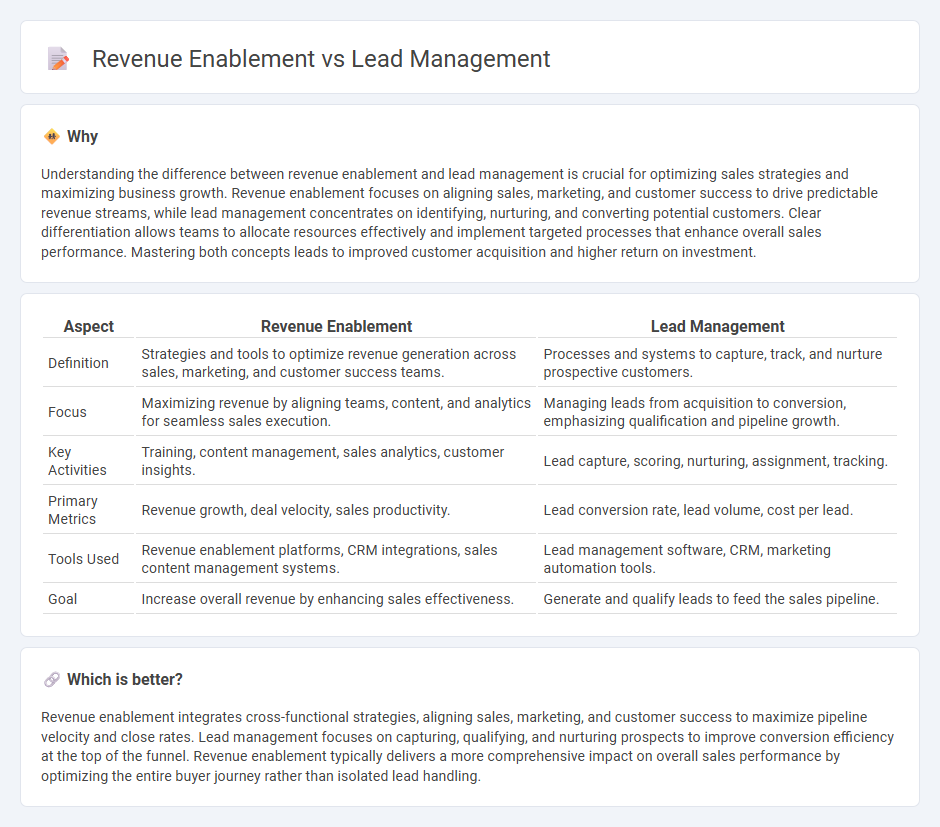
Revenue enablement focuses on aligning marketing, sales, and customer success teams to optimize the entire buyer journey and accelerate deal closures. Lead management involves capturing, nurturing, and qualifying prospects to ensure a consistent and high-quality sales pipeline. Discover how integrating these strategies can boost your sales performance and drive sustainable revenue growth.
Why it is important
Understanding the difference between revenue enablement and lead management is crucial for optimizing sales strategies and maximizing business growth. Revenue enablement focuses on aligning sales, marketing, and customer success to drive predictable revenue streams, while lead management concentrates on identifying, nurturing, and converting potential customers. Clear differentiation allows teams to allocate resources effectively and implement targeted processes that enhance overall sales performance. Mastering both concepts leads to improved customer acquisition and higher return on investment.
Comparison Table
| Aspect | Revenue Enablement | Lead Management |
|---|---|---|
| Definition | Strategies and tools to optimize revenue generation across sales, marketing, and customer success teams. | Processes and systems to capture, track, and nurture prospective customers. |
| Focus | Maximizing revenue by aligning teams, content, and analytics for seamless sales execution. | Managing leads from acquisition to conversion, emphasizing qualification and pipeline growth. |
| Key Activities | Training, content management, sales analytics, customer insights. | Lead capture, scoring, nurturing, assignment, tracking. |
| Primary Metrics | Revenue growth, deal velocity, sales productivity. | Lead conversion rate, lead volume, cost per lead. |
| Tools Used | Revenue enablement platforms, CRM integrations, sales content management systems. | Lead management software, CRM, marketing automation tools. |
| Goal | Increase overall revenue by enhancing sales effectiveness. | Generate and qualify leads to feed the sales pipeline. |
Which is better?
Revenue enablement integrates cross-functional strategies, aligning sales, marketing, and customer success to maximize pipeline velocity and close rates. Lead management focuses on capturing, qualifying, and nurturing prospects to improve conversion efficiency at the top of the funnel. Revenue enablement typically delivers a more comprehensive impact on overall sales performance by optimizing the entire buyer journey rather than isolated lead handling.
Connection
Revenue enablement aligns sales, marketing, and customer success teams by providing tools and data that optimize the entire buyer journey. Effective lead management captures, scores, and nurtures prospects, ensuring high-quality leads are prioritized and seamlessly handed off to sales. This connection drives consistent revenue growth by improving conversion rates and accelerating the sales cycle.
Key Terms
**Lead Management:**
Lead management involves capturing, tracking, and nurturing prospects to convert them into customers, emphasizing effective CRM integration and lead scoring to prioritize sales efforts. It focuses on data quality, segmentation, and automated workflows to enhance sales pipeline efficiency and accelerate deal closure rates. Explore further to understand how optimizing lead management transforms your sales strategy and boosts revenue growth.
Lead Scoring
Lead scoring in lead management quantifies prospects' readiness to buy by assigning values based on behaviors and demographics, streamlining sales prioritization and increasing conversion rates. Revenue enablement expands on this by integrating lead scoring with cross-department alignment, optimized content delivery, and analytic insights to accelerate pipeline velocity and maximize revenue growth. Explore the strategic differences between lead management and revenue enablement to enhance your sales performance.
Lead Nurturing
Lead management centers on systematically capturing, tracking, and nurturing leads to guide prospects through the sales funnel efficiently while increasing conversion rates. Revenue enablement broadens this scope by integrating sales, marketing, and customer success strategies to optimize revenue generation through targeted lead nurturing and personalized engagement. Explore how aligning lead nurturing with revenue enablement can maximize sales performance and drive business growth.
Source and External Links
A Complete Guide to Lead Management - LeadsBridge - Lead management involves building a system to capture, nurture, and convert leads into customers by qualifying quickly, segmenting smartly, automating with purpose, keeping data clean, aligning sales and marketing, tracking key metrics, fixing stuck stages, and standardizing processes.
What is Lead Management? - TechnologyAdvice - Lead management is the process from identifying potential clients to converting them, encompassing components like lead scoring, segmentation, nurturing strategies, and tracking with analytics to drive personalized communication and improved sales results.
What Is Lead Management? Definition, Tips & Strategies - Salesforce - Lead management manages prospective customers through their journey using CRM tools to track interactions, balance automation and personal touch, qualify leads early, and continuously optimize the sales cycle to increase conversion efficiency.
 dowidth.com
dowidth.com